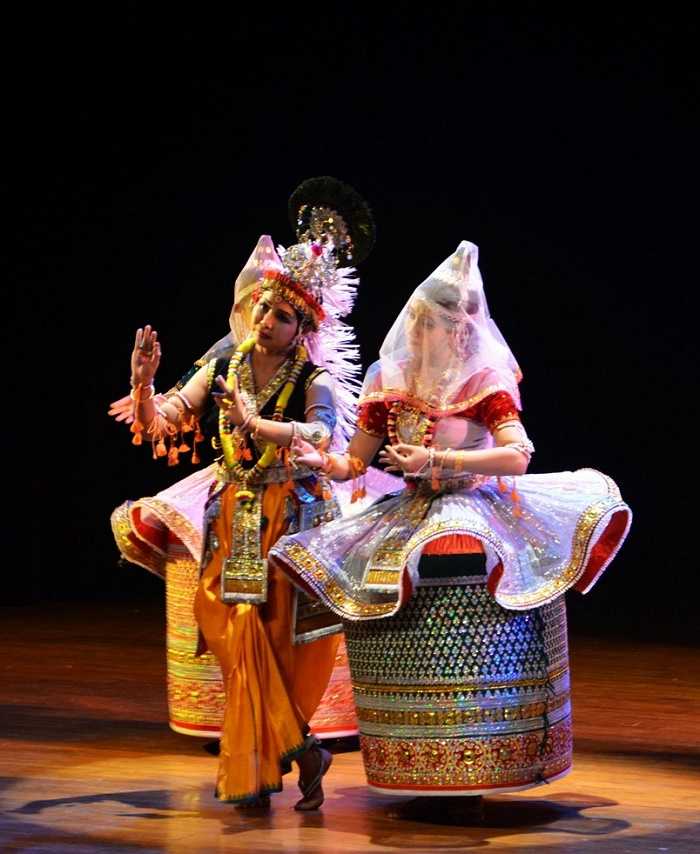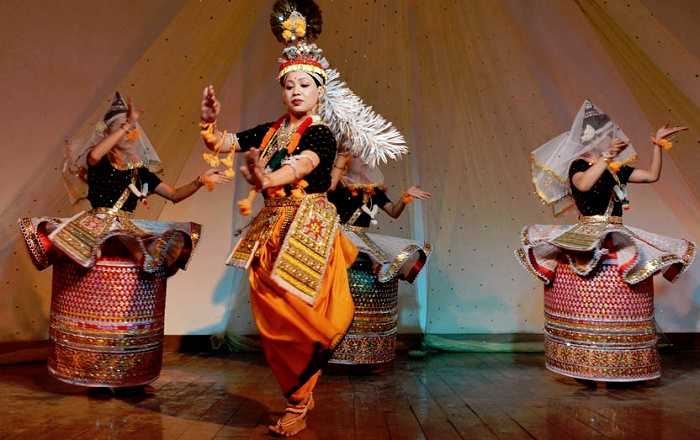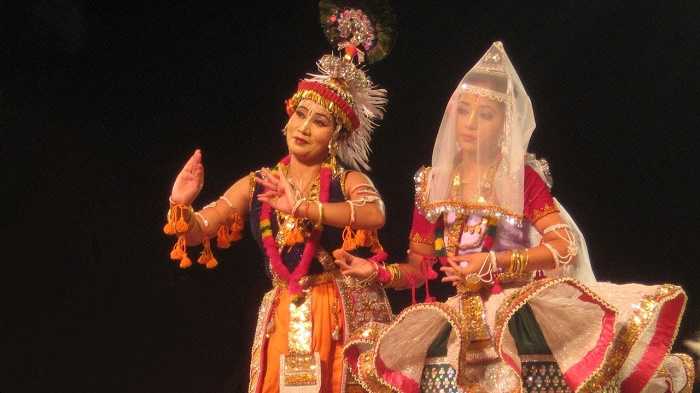
Image Credit: http://sehernow.in/images-ananya2014/PritiPatel/002.jpg
Manipuri dance is counted among major classical dance forms of India, especially noted for themes based on Vaishnavism and spectacular execution of ‘Ras Lila’, dance dramas based on love between Radha and Krishna. Other themes included in this art form associate with Shaktism, Shaivism and on the sylvan deities called Umang Lai during Manipuri festival ‘Lai Haraoba’. This dance form is named after the north-eastern state of Manipur, India from where it originated but it has its roots in ‘Natya Shastra’, the age-old Sanskrit Hindu text. A mix of Indian and southeast Asian culture is palpable in this form. The age-old dance tradition of the place is manifested from great Indian epics, ‘Ramayana’ and ‘Mahabharata’, where the native dance experts of Manipur are referred as ‘Gandharvas’. The Manipuris perform this religious art that aims at expressing spiritual values during Hindu festivals and other important cultural occasions like marriage.
History & Evolution
Traditionally the Manipuri people consider themselves to be the ‘Gandharvas’ mentioned in the Vedic texts who were singers, dancers and musicians associated with devas or the deities. Southeast Asian temples of early medieval period bear sculptures of ‘Gandharvas’ as dancers. The region is also mentioned as ‘Gandharva-desa’ in ancient Manipuri texts. Usha, the exalted dawn goddess in the ‘Rig Veda’ is traditionally accredited of creating female dance art and tutoring girls in the art. Conventionally this oral tradition of dance passed down verbally to women is famous in Manipur as ‘Chingkheirol’. Manipur finds place in age-old Sanskrit texts including the great Indian epic, the ‘Mahabharata’, which mentions that one of the five Pandava brothers, Arjun met Chitrangada and fell in love with her in this beautiful valley. The ethnic majority of Meitei people call dance as ‘Jagoi’ and the traditional ‘Lai Haraoba’ festival observed in honour of the sylvan deities called Umang Lai includes several dance postures of Nataraja, an illustration of Lord Shiva as the cosmic ecstatic dancer, as also His disciple Tandu or Tangkhu. The ‘Khamba Thoibi’ dance is performed during ‘Lai Haraoba’. It is a duet dance of male and female partners that is dedicated to the sylvan deity, Thangjing of Moiran, and associated with the Manipuri folklore of two lovers an orphan boy Khamba and a princess Thoibi, daughter of King Chinkhuba, from the epic ‘Moirang Parba’.

Development in the Medieval era
Although texts of ancient Manipur gradually fizzled out, the oral tradition of Manipuri, records tracing back to early 18th century, have references about the place in Asian manuscripts and archaeological findings speak volumes about the art. The text ‘Bamon Khunthok’ that gives an account of migration of Hindu Brahmins and Buddhists to Manipur elucidates that the practice of Vaishnavism was embraced by Manipur Kings during the 15th century CE. Later, Vaishnavism was not only adopted by King Charai Rongba in 1704 but was also declared as the state religion.
The Chaitanya style of devotional Vaishnavism was embraced by King Gareeb Niwaz in 1717 that saw accentuation of religious performance arts including singing and dancing based on themes surrounding Lord Krishna. Manipuri furthered its dance tradition by incorporating dance dramas based on Lord Rama in 1734. Rajarshi Bhagya Chandra also known as Jai Singh Maharaja and Ningthou Ching-Thang Khomba, the 18th century CE monarch of Meitei people who adopted Gaudiya Vaishnavism is considered an icon in the history of Manipur. The invention of ‘Ras Lila’ dance and spreading Vaishnavism in the state of Manipur is attributed to him.
He recorded and systematized the style of Manipuri dance art and is credited with composing three forms of ‘Ras Lilas’ out of five namely ‘Kunja Ras’, ‘Basanta Ras’ and ‘Maha Ras’, which were staged during his monarchy in Imphal’s Sri Sri Govindaji temple. He also elaborated the basics of the dance in the text titled ‘Govinda Sangeet Lila Vilasa’, composed the ‘Achouba Bhangi Pareng’ dance, designed the ‘Kumil’ costume and initiated the dance form in Hindu temples and ‘Ras Lila’ performances in public. It is also considered that encouraged by Bengali missionaries, he initiated the Sankirtan tradition in Manipur.
Maharaja Gambhir Singh and Maharaja Chandra Kirti Singh of the 19th century are accredited with composing the ‘Nitya Ras’. While the former composed ‘Goshtha Vrindaban Pareng’ and ‘Goshtha Bhangi Pareng’ (two parengs of tandava kind), the latter composed ‘Vrindaban Bhangi Pareng’ and ‘Khrumba Bhangi Pareng’ (two parengs of Lasya kind), along with around 64 Pung choloms or drum dances that are usually performed as a prelude to the ‘Ras Lila’.
Colonial Era
British colonial rule in the 19th century saw decline of various Indian classical dance forms which were subjected to contemptuous fun and discouragement. Manipur was annexed by the British colonial government in 1891, and with this the flourishing period of Manipuri dance art came under the clutch of colonial rule like other ancient Indian classical dance forms. The Manipuri dancers somehow survived in the temples of the region like the Govindji temple of Imphal. The Christian missionaries launched anti-dance movement in 1892 and later the Madras Presidency under the British colonial government banned the custom of dancing in Hindu temples in 1910. The Indian community disapproved such ban and as the Indian freedom movement progressed steadily during the early 20th century, an effort to revive Indian culture and tradition became strong among Indians. Many classical art revivalists joined hands between 1920 and 1950 in reviving the different ancient classical dance forms.

Association with Rabindranath Tagore
Rabindranath Tagore, an Indian Bengali polymath and the first non-European who won the ‘Nobel Prize in Literature’ in 1913, is revered for his outstanding contribution in the field of Bengali literature and music. He rekindled the Manipuri dance art in a new way. Tagore was so fascinated by the performance of the dance composition of ‘Goshtha Lila’ in Sylhet (now in Bangladesh) in 1919 that he offered Guru Budhimantra Singh, an ace Manipuri dancer, to join the faculty of ‘Shantiniketan’, an Indian cultural and study centre. Guru Naba Kumar was also invited by Tagore who joined ‘Shantiniketan’ in 1926 to teach ‘Ras Lila’. Many of Tagore’s dance-dramas were given shape with choreography of other imminent Gurus who were offered to join the centre at certain points of time namely Atomba Singh, Nileshwar Mukherji and Senarik Singh Rajkumar.
Repertoire
The repertoire and basic play of this dance form revolves around different seasons. The traditional style of this art form incorporates graceful, gentle and lyrical movements. The fundamental dance movement of Ras dances of Manipur is Chari or Chali. Manipuri dances are performed thrice in autumn from August to November and once in spring sometime around March-April, all on full moon nights. While Vasant Ras is scheduled in spring when Holi, the festival of colours is celebrated by the Hindus, the other dances are scheduled around post-harvest festivals like Diwali. Themes of the songs and plays comprise of love and association of Radha and Krishna in company of the Gopis namely Sudevi, Rangadevi, Lalita, Indurekha , Tungavidya, Vishakha, Champaklata and Chitra. One composition and dance sequence is dedicated for each of the Gopis while the longest sequence is emphasized on Radha and Krishna. The dance drama is performed through excellent display of expressions, hand gestures and body language. Acrobatic and vigorous dance movements are also displayed by Manipuri dancers in many other plays.

Costumes
The costumes for Manipuri dancers, particularly for women are quite unique from other Indian classical dance forms. A male dancer wears a bright coloured dhoti, also referred as dhora or dhotra that covers lower part of his body from waist. The unique style of wearing it gives the dancer the flexibility to perform his footwork. A crown decorated with peacock feather adorns the dancer’s head, who portrays the character of Lord Krishna. The costume of female dancers resembles that of a Manipuri bride, referred as Potloi costumes. These costumes were introduced for dancers characterising Gopis in ‘Rasa Lila’ dance by Meidingu Bhagyachandra Maharaj. The most distinguished of these is the Kumil costume that is an exquisitely embellished long skirt in the shape of a barrel with a stiffened bottom. The skirt is embroidered with fine gold and silver works decorated with small mirror pieces and designs of lotus and other natural items as border prints. The top border of Kumil adorns a wavy and translucent fine skirt tied in three places around the waist in Trikasta and opens up like a flower. A velvet choli or blouse adorns the upper part of the body and a translucent veil white in colour covers the head. The dancer wears round shaped jewellery or garlands of flowers to adorn her face, hand, neck, waist and legs that synchronize well with her costume. However unlike other Indian classical dance forms a Manipuri dancer does not wear a ghunghroo that is a musical anklet made of leather straps with small metallic bells attached to it. The entire get up of the dancers performing gracefully onstage complimented with devotional music gives the feel of watching floating apsaras.
The drummers who also dance while drumming are male artists. They wear white dhoti that covers the lower part of body from waist and a white turban on the head. A shawl neatly folded adorns their left shoulders while the drum strap falls on their right shoulders.

Image Credit: verticalresponse.com
Instruments & Music
The musical instrument generally used in this art form includes the Pung that is a barrel drum, cymbals or kartals, harmonium, flute, pena and sembong. Accompanists include a singer. During the Pong cholom dance, which is normally performed as a prelude to ‘Ras Lila’, dancer-drummers perform spectacular footwork including dance jumps while drumming. Similarly in Kartal cholom dance the dancers performing in group play the kartals or cymbals and dance to its rhythm forming and moving in a circle. While Pong cholom and Kartal cholom are performed by male artists, Mandilla cholom is performed by women in group while playing cymbals that are tied with colourful tassel strings. The language of text songs of Manipuri dance lyrics are varied including Sanskrit, Brij Bhasha and Maithili to name a few while the text songs are generally taken from poetry of the likes of Jayadeva, Govindadas, Chandidas and Vidyapati.
Famous Exponents
Imminent Manipuri performers include Guru Bipin Singh, his disciple Darshana Jhaveri and her sisters Nayana, Ranjana and Suverna, Charu Mathur and Devyani Chalia among others.



